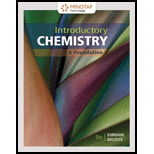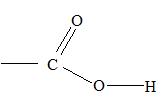
Introductory Chemistry
9th Edition
ISBN: 9781337399524
Author: Steven S. Zumdahl, Donald J. DeCoste
Publisher: Cengage Learning
expand_more
expand_more
format_list_bulleted
Concept explainers
Question
Chapter 20, Problem 76QAP
Interpretation Introduction
Interpretation:
Determine the acidity of
Concept Introduction:
Acid is some sort of chemical which provides protons or hydrogen ions and/or accepts electrons. Usually acids contain a hydrogen atom bonded that can release (dissociate) to produce cation and anion in water, which is called as acid ionization.
Carboxylic acid is comprised of

Expert Solution & Answer
Want to see the full answer?
Check out a sample textbook solution
Students have asked these similar questions
H-
H
H
H
H
H
H
Identify and select all structures below that represent a constitutional isomer(s) of the compound shown above.
H-
H
H
H
A.
H
H
H
H-C
CI
H
H
D.
H
H
H
H
H
H
C
C
-H
H
C
C
H
H
H
H
B.
H
CI
H
H-
C
C
H
H
H
H
E.
H
CI
H
C.
Why doesn't this carry on to form a ring by deprotonating the alpha carbon and the negatively-charged carbon attacking the C=O?
6. A solution (0.0004 M) of Fe(S2CNEt2)3 (see the structural drawing below) in chloroform
has absorption bands at:
350 nm (absorbance A = 2.34);
514 nm(absorbance A = 0.0532);
Calculate the molar absorptivity values for these bands. Comment
on their possible nature (charge transfer transitions or d-d
S
N-
transitions?).
(4 points)
Chapter 20 Solutions
Introductory Chemistry
Ch. 20.2 - Exercise 20.1 Give the molecular formulas for the...Ch. 20.4 - Exercise 20.2 Name the following molecules. a. b.Ch. 20.4 - Exercise 20.3 Write the structural formula for...Ch. 20.5 - Petroleum is a very valuable raw material for the...Ch. 20.7 - Exercise 20.4 Name the following molecules. a. b.Ch. 20.9 - Prob. 20.5SCCh. 20.11 - Prob. 20.6SCCh. 20.14 - Prob. 20.7SCCh. 20 - What is meant by the term “unsaturated...Ch. 20 - Prob. 2ALQ
Ch. 20 - Prob. 3ALQCh. 20 - How many different possible “tetramethylbenzenes”...Ch. 20 - For the general formula C6H14O, draw the...Ch. 20 - Prob. 6ALQCh. 20 - Prob. 1QAPCh. 20 - Your roommate, a chemistry major, claims to have...Ch. 20 - Prob. 3QAPCh. 20 - How many electron pairs are shared when a triple...Ch. 20 - Prob. 5QAPCh. 20 - Prob. 6QAPCh. 20 - Prob. 7QAPCh. 20 - Prob. 8QAPCh. 20 - Prob. 9QAPCh. 20 - . The chains in normal alkanes are not really...Ch. 20 - Prob. 11QAPCh. 20 - Prob. 12QAPCh. 20 - . Give the name of each of the following...Ch. 20 - Prob. 14QAPCh. 20 - . What are structural isomers? Which is the...Ch. 20 - Prob. 16QAPCh. 20 - Prob. 17QAPCh. 20 - Prob. 18QAPCh. 20 - Prob. 19QAPCh. 20 - Prob. 20QAPCh. 20 - . What is an alkyl group? How is a given alkyl...Ch. 20 - . When naming alkanes, find the longest continuous...Ch. 20 - Prob. 23QAPCh. 20 - . When naming alkanes, the alkyl groups are listed...Ch. 20 - . Give the systematic name for each of the...Ch. 20 - . Give the systematic name for each of the...Ch. 20 - Prob. 27QAPCh. 20 - Prob. 28QAPCh. 20 - Prob. 29QAPCh. 20 - Prob. 30QAPCh. 20 - . What is pyrolytic cracking, and why is the...Ch. 20 - Prob. 32QAPCh. 20 - . Explain why alkanes are relatively unreactive.Ch. 20 - Prob. 34QAPCh. 20 - . Indicate the missing molecule in each of the...Ch. 20 - Prob. 36QAPCh. 20 - Prob. 37QAPCh. 20 - Prob. 38QAPCh. 20 - Prob. 39QAPCh. 20 - Prob. 40QAPCh. 20 - Prob. 41QAPCh. 20 - Prob. 42QAPCh. 20 - Prob. 43QAPCh. 20 - Prob. 44QAPCh. 20 - Prob. 45QAPCh. 20 - Prob. 46QAPCh. 20 - Prob. 47QAPCh. 20 - Prob. 48QAPCh. 20 - Prob. 49QAPCh. 20 - . Benzene exhibits resonance Explain this...Ch. 20 - . How is a monosubstituted benzene named? Give the...Ch. 20 - Prob. 52QAPCh. 20 - Prob. 53QAPCh. 20 - . What do the prefixes ortho-, meta-, and para-...Ch. 20 - Prob. 55QAPCh. 20 - Prob. 56QAPCh. 20 - Prob. 57QAPCh. 20 - Prob. 58QAPCh. 20 - . What functional group characterizes an alcohol?...Ch. 20 - Prob. 60QAPCh. 20 - . Give the systematic name for each of the...Ch. 20 - . Is 1-pentanol a primary, secondary, or tertiary...Ch. 20 - . Why is methanol sometimes called wood alcohol?...Ch. 20 - Prob. 64QAPCh. 20 - . Write the equation for the synthesis of ethanol...Ch. 20 - . What is the simplest aromatic alcohol commonly...Ch. 20 - Prob. 67QAPCh. 20 - Prob. 68QAPCh. 20 - Prob. 69QAPCh. 20 - Prob. 70QAPCh. 20 - Prob. 71QAPCh. 20 - Prob. 72QAPCh. 20 - Prob. 73QAPCh. 20 - Prob. 74QAPCh. 20 - Prob. 75QAPCh. 20 - Prob. 76QAPCh. 20 - Prob. 77QAPCh. 20 - Prob. 78QAPCh. 20 - Prob. 79QAPCh. 20 - Prob. 80QAPCh. 20 - Prob. 81QAPCh. 20 - . Draw a structural formula for each of the...Ch. 20 - Prob. 83QAPCh. 20 - Prob. 84QAPCh. 20 - Prob. 85QAPCh. 20 - Prob. 86QAPCh. 20 - Prob. 87QAPCh. 20 - Prob. 88QAPCh. 20 - Prob. 89APCh. 20 - Prob. 90APCh. 20 - Prob. 91APCh. 20 - Prob. 92APCh. 20 - Prob. 93APCh. 20 - . The systematic names of all saturated...Ch. 20 - Prob. 95APCh. 20 - Prob. 96APCh. 20 - Prob. 97APCh. 20 - Prob. 98APCh. 20 - Prob. 99APCh. 20 - . With very reactive agents, such as the halogen...Ch. 20 - . Alkenes and alkynes are characterized by their...Ch. 20 - Prob. 102APCh. 20 - Prob. 103APCh. 20 - Prob. 104APCh. 20 - Prob. 105APCh. 20 - Prob. 106APCh. 20 - Prob. 107APCh. 20 - Prob. 108APCh. 20 - Prob. 109APCh. 20 - Prob. 110APCh. 20 - Prob. 111APCh. 20 - Prob. 112APCh. 20 - Prob. 113APCh. 20 - Prob. 114APCh. 20 - Prob. 115APCh. 20 - . Give the systematic name for each of the...Ch. 20 - Prob. 117APCh. 20 - Prob. 118APCh. 20 - Prob. 119APCh. 20 - Prob. 120APCh. 20 - Prob. 121APCh. 20 - Prob. 122APCh. 20 - Prob. 123APCh. 20 - Prob. 124APCh. 20 - Prob. 125APCh. 20 - Prob. 126APCh. 20 - Prob. 127APCh. 20 - Prob. 128APCh. 20 - Prob. 129APCh. 20 - Prob. 130APCh. 20 - Prob. 131APCh. 20 - . Write the formula for the missing reactant or...Ch. 20 - Prob. 133APCh. 20 - Prob. 134APCh. 20 - . Name each of the following aromatic or...Ch. 20 - Prob. 136APCh. 20 - Prob. 137APCh. 20 - Prob. 138APCh. 20 - Prob. 139APCh. 20 - Prob. 140APCh. 20 - Prob. 141APCh. 20 - . Name each of the following alkanes....Ch. 20 - Prob. 143CPCh. 20 - Prob. 144CPCh. 20 - Prob. 145CPCh. 20 - Prob. 146CPCh. 20 - Prob. 147CP
Knowledge Booster
Learn more about
Need a deep-dive on the concept behind this application? Look no further. Learn more about this topic, chemistry and related others by exploring similar questions and additional content below.Similar questions
- What is the mechanism for this?arrow_forwardFor questions 1-4, consider the following complexes: [Co(CN)6], [COC14]², [Cr(H2O)6]²+ 4. Room temperature (20°C) measurement of molar magnetic susceptibility (Xm) for Fe(NH4)2(SO4)2×6H2O is 1.1888 x 102 cgs (Gaussian units). Calculate effective magnetic moment and provide a number of unpaired electrons for the iron ion. Use this number to rationalize the coordination geometry around iron center. (4 points)arrow_forward7. Describe the expected 31P and 19F (where applicable) NMR spectral patterns for the following compounds (indicate number of signals and their splitting patterns). a) tetraphenyldiphosphine Ph Ph P-P Ph Ph Ph Ph ' b) tetraphenyldiphosphine monoxide P-P-Ph Ph (2 points) (2 points c) tetrafluorophosphonium hexafluorophosphate [PF4]*[PF6]¯ (4 points)arrow_forward
- 3. For questions 1-4, consider the following complexes: [Co(CN)6]4, [COC14]², [Cr(H2O)6]²+ Which (if any) of these complexes would be expected to display Jahn-Teller distortion? (2 points)arrow_forwardWhat is Instrumental Neutron Activation and what are the advantages and disadvantages in using its applications? (I'm doing an in class assignment and need better understanding of what the instrument can be used for) Please include references so that I can better understand the application of how the instrument works!arrow_forwardWhat is Isotope Analysis and what are the advantages and disadvantages in using its applications and instrumentalization? Please include references so that I can better understand how the instrument works!arrow_forward
- 5. Count the electrons on the following complexes and state whether they follow the 18- electron rule: (3 points) Fe(CO)5 Ni(PMe3)4 PMe3 is trimethylphosphine Mn(CO)5Brarrow_forwardFor questions 1-4, consider the following complexes: [Co(CN)6]+, [CoCl4]², [Cr(H2O)6]²+ 2. Draw the corresponding d-orbital splitting for each of the complexes; predict the spin- state (low-spin/high spin) for each of the complexes (if applicable); explain your arguments. Calculate the crystal field stabilization energy for each complex (in Ao or At). (6 points)arrow_forwardFor questions 1-4, consider the following complexes: [Co(CN)6]4, [COC14]², [Cr(H2O)6]²+ 1. Assign oxidation number to the metal, then indicate d-electron count. (3 points)arrow_forward
- Using iodometry I want to titrate a sodium thiosulfate solution and I use 15 mL. If I have 50 mL of a 0.90 M copper solution and KI, what will be the molarity of sodium thiosulfate?arrow_forwardDraw the product formed when the following pair of compounds is treated with NaOEt in ethanol. + i CNarrow_forwardI need help with the followingarrow_forward
arrow_back_ios
SEE MORE QUESTIONS
arrow_forward_ios
Recommended textbooks for you
 World of Chemistry, 3rd editionChemistryISBN:9781133109655Author:Steven S. Zumdahl, Susan L. Zumdahl, Donald J. DeCostePublisher:Brooks / Cole / Cengage Learning
World of Chemistry, 3rd editionChemistryISBN:9781133109655Author:Steven S. Zumdahl, Susan L. Zumdahl, Donald J. DeCostePublisher:Brooks / Cole / Cengage Learning Introductory Chemistry: A FoundationChemistryISBN:9781337399425Author:Steven S. Zumdahl, Donald J. DeCostePublisher:Cengage Learning
Introductory Chemistry: A FoundationChemistryISBN:9781337399425Author:Steven S. Zumdahl, Donald J. DeCostePublisher:Cengage Learning Chemistry for Today: General, Organic, and Bioche...ChemistryISBN:9781305960060Author:Spencer L. Seager, Michael R. Slabaugh, Maren S. HansenPublisher:Cengage Learning
Chemistry for Today: General, Organic, and Bioche...ChemistryISBN:9781305960060Author:Spencer L. Seager, Michael R. Slabaugh, Maren S. HansenPublisher:Cengage Learning Principles of Modern ChemistryChemistryISBN:9781305079113Author:David W. Oxtoby, H. Pat Gillis, Laurie J. ButlerPublisher:Cengage Learning
Principles of Modern ChemistryChemistryISBN:9781305079113Author:David W. Oxtoby, H. Pat Gillis, Laurie J. ButlerPublisher:Cengage Learning Introductory Chemistry: An Active Learning Approa...ChemistryISBN:9781305079250Author:Mark S. Cracolice, Ed PetersPublisher:Cengage Learning
Introductory Chemistry: An Active Learning Approa...ChemistryISBN:9781305079250Author:Mark S. Cracolice, Ed PetersPublisher:Cengage Learning Organic And Biological ChemistryChemistryISBN:9781305081079Author:STOKER, H. Stephen (howard Stephen)Publisher:Cengage Learning,
Organic And Biological ChemistryChemistryISBN:9781305081079Author:STOKER, H. Stephen (howard Stephen)Publisher:Cengage Learning,

World of Chemistry, 3rd edition
Chemistry
ISBN:9781133109655
Author:Steven S. Zumdahl, Susan L. Zumdahl, Donald J. DeCoste
Publisher:Brooks / Cole / Cengage Learning

Introductory Chemistry: A Foundation
Chemistry
ISBN:9781337399425
Author:Steven S. Zumdahl, Donald J. DeCoste
Publisher:Cengage Learning

Chemistry for Today: General, Organic, and Bioche...
Chemistry
ISBN:9781305960060
Author:Spencer L. Seager, Michael R. Slabaugh, Maren S. Hansen
Publisher:Cengage Learning

Principles of Modern Chemistry
Chemistry
ISBN:9781305079113
Author:David W. Oxtoby, H. Pat Gillis, Laurie J. Butler
Publisher:Cengage Learning

Introductory Chemistry: An Active Learning Approa...
Chemistry
ISBN:9781305079250
Author:Mark S. Cracolice, Ed Peters
Publisher:Cengage Learning

Organic And Biological Chemistry
Chemistry
ISBN:9781305081079
Author:STOKER, H. Stephen (howard Stephen)
Publisher:Cengage Learning,